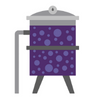What Can Happen When Good Wine Goes Bad?
Without proper and accurate analysis in the winemaking process, you can easily lose valuable products to improper acidity, microbial instability, and spoilage.
Pre-Fermentation
Adjust acidity and nutrients for the addition of tartaric acid, to maintain a low pH, and of diammonium phosphate as a nitrogen source for fermentation.
What can happen without relevant analysis of pH, titratable acidity (TA), and ammonia nitrogen?
pH affects SO2 antimicrobial action, growth of spoilage organisms, color and flavor. The lower the pH the lower the risk for microbial spoilage and sulfites prevent wine from spoiling.
TA affects the taste of wine and can adjust pH levels.
Nitrogen affects how much nutrient is required to prevent stuck fermentation.
Fermentation
During fermentation, yeast turns sugar into alcohol; contact time with skins, seeds, and stems influences the tannins, flavors, and colors of wine.
What can happen without relevant analysis of pH, titratable acidity (TA), and ammonia nitrogen?
pH affects colors, SO2 additions, malolactic fermentation, and spoilage organisms.
Nitrogen nutrients affect fermentation.
SO2 levels can be adjusted to inhibit any native yeast fermentation that could be on the grapes before primary fermentation.
Post-Fermentation
Post-fermentation has four factors to consider.
Clarification
Filter systems are used to clarify wine and remove yeast after fermentation
What can happen without relevant analysis of turbidity?
Clarity is a feature of wine and microbial stability is important for long wine shelf-life.
Racking
Wine is racked to aid in clarification of clean wine SO2 may be added in this step to suppress bacteria introduced in this process.
What can happen without relevant analysis of turbidity, clarity, sulfur dioxide, dissolved oxygen in tanks or barrels, titratable acidity, and pH?
Excess air exposure will increase the O2 in a barrel which can destroy the flavor of wine through oxidation, causing off flavors before wine maturation.
Aging
Wine is put in barrels or tanks to age.
What can happen without frequent analysis of pH, sulfur dioxide, dissolved oxygen in tanks or barrels, titratable acidity (TA)?
pH is adjusted for microbial stability, as it’s the molecular form of SO2 that will inhibit microbial stability. Some grapes typically have lower pH than others.
SO2 affects microbiological growth and provides antioxidant protection.
O2 exposure, in barrels and tanks, needs to be monitored to prevent oxidation.
TA influences taste balance between sour or flat.
Bottling and Further Aging
Wine may be sterile filtered and is packaged in bottles.
What can happen without frequent analysis of pH, sulfur dioxide, dissolved oxygen in bottles, titratable acidity (TA), turbidity/clarity measurement?
pH, TA, and SO2 levels are important and should be periodically checked to ensure they are within specification.
Measure DO in the tank during bottling to ensure that the headspace gassing is adequate to not allow O2 pickup as the tank is emptied. Confirm by measuring DO in the wine right after it has been bottled.
Turbidity is important for making sure filters do not clog and ensuring a clear wine without any haze.
Without Proper and Accurate Analysis
pH: Potential growth of spoilage organisms, colors, and SO2 additions.
TA: Taste and spoilage, malolactic fermentation, balance between sour and flat.
Dissolved Oxygen: Too much can lead to flavor degradation and wine spoilage.
Sulfur Dioxide: Affects microbiological growth and malolactic fermentation; helps prevent oxidation.
Nitrogen: Affects how much nutrient to prevent stuck fermentation.
Using the Right Tools
Using the right tools and analyses can remedy complications
and are the foundation of good winemaking.
Information courtesy of Thermo Fisher Scientific








